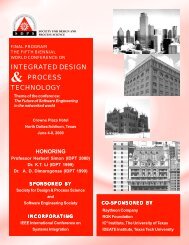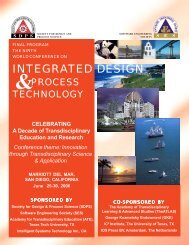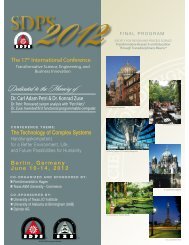IDPT(SDPS) 2008 Asia University
IDPT(SDPS) 2008 Asia University
IDPT(SDPS) 2008 Asia University
- No tags were found...
Create successful ePaper yourself
Turn your PDF publications into a flip-book with our unique Google optimized e-Paper software.
mation Technology Association (TAITA), Taiwan Agricultural Association,and the National 4-H Association of Taiwan, respectively.Dr. Peng’s teaching and research areas cover Knowledge Management,Technology and Innovation Management, and ChineseIndustrial and Agricultural Development. Professor Peng has participatedin many international academic conferences and seminars,such as APO, AFITA, ASABE, etc. He has also edited manyjournals.Professor Oktay SinanogluYale <strong>University</strong>Endowed Chair, Molecular BiologyProfessor Oktay Sinanoglu has been nominated twice for NobelPrize. He is a Turkish scientist of theoretical chemistry and molecularbiology. At age 28, he became the youngest person in 20th centuryat Yale <strong>University</strong> to attain status as a full professor. Sinanogluwas born in 1935 in Bari, Italy where his father served as a consulgeneral. The family returned to Turkey at the start of World War II in1939. In 1953, he attended TED Yenisehir Lisesi high school inAnkara, and after graduating won a scholarship for education ofchemistry in the United States. In 1956, he graduated from the <strong>University</strong>of California, Berkeley in chemical engineering with the highestrank. In only eight months, he graduated from MIT in 1957 withthe highest degree. In two years, he finished his doctorate at UCBerkeley. In 1960, Sinanoglu started working as associate professorat Yale <strong>University</strong>. He theorized the "Many-Electron Theory ofAtoms and Molecules" in 1962 by solving a mathematical theoremthat had been unsolved for 50 years. The same year, he earned theAlfred P. Sloan prize. He was appointed full professor in 1961. Hegot his second life-long chair in Yale in Molecular Biology. ProfessorSinanoglu was the first to earn the Alexander von Humboldt’s SciencePrize in 1973. In 1975, he won the award of Japan’s InternationalOutstanding Scientist. In the 1980s, he theorized a newmethod from 180 theories concerning mathematics and physics,considered revolutionary, which enables chemists to predict the waysin which chemicals combine in the laboratory and to solve othercomplex problems in chemistry using simple pictures and periodictables. Also, he took his place in the Academy of Arts & Sciences. In1993, he moved to Turkey to teach at the Yildiz Teknik Universitesi,and officially retired at the age of 67. Yet his scientific researcheshave not ceased. He received several international and local awardsconcerning his scientific and social contributions and efforts. Hehas been to many places including <strong>Asia</strong> and Latin America. He triedto establish strong communications between Japan, India and Turkey.Because of his efforts, he was given the title "Special Emissary"of Japan-Turkey. He worked for better education, purified languagein Turkey most of his life and strived to form a conscious generation.Lily YehFounder, Artists without BordersLily Yeh is an internationally celebrated artist and award-winningfounder and former executive and artistic director of the Village ofArts and Humanities. Since 1986, with the help of neighborhoodchildren and adults, Yeh has built the Village from an abandonedlot into an organization and a community. She has infused the Villagewith her own artistic sensitivity and vision, collaborating with otherartists and community residents to create a place that brings artinto both the physical space and daily rhythms of life. Expandingbeyond North Philadelphia, Yeh’s work has taken her tocommunities in other parts of the country as well as abroad.Born in Kueizhou China, Yeh studied traditional Chinese paintingin Taiwan before coming to the United States in 1963. In 1968, shebegan teaching at the <strong>University</strong> of the Arts where she becameprofessor of painting and art history. In 1998, she resigned fromher tenured position to devote all her time to her work at the Villageof Arts and Humanities. Under her leadership as founder, executivedirector and lead artist from 1968 to 2004, the Village has becomea national model of community building through the arts. In the lastfive years of her tenure there, the Village has received severalnational awards including Coming Up Taller Award from thePresident’s Committee on Arts and Culture and the NationalEndowment for the Arts, Washington, D.C. in 2000 and the goldmedal Rudy Bruner Award for Urban Excellence from BrunerFoundation in Cambridge, MA. In 2003, the Village received aCommonwealth of Pennsylvania Governor’s Award forEnvironmental Excellence. In the same year, Yeh received theprestigious “Leadership for the Changing World” Award from theFord Foundation. In 2007, the Village is being honored withChampion in Action Award by Citizens Bank for its buildingcommunity through the arts effort.In 2004, Yeh left the Village to pursue her work internationally. Sheformed a new non-profit organization, Barefoot Artists, Inc., with themission to bring the transformative power of art to the mostimpoverished communities in the world through participatory andmultifaceted projects that foster community empowerment, improvethe physical environment, promote economic development, andpreserve indigenous art and culture. Yeh has conducted lectures,workshops and land transformation projects in many places in theworld. Her current work, the Rwanda Healing Project, includes theconstruction of the 1994 Genocide Memorial and the transformationof a survivors village in the Rugerero district in West Rwanda. Ithas won her the SEGD (Society for Environmental Graphic Design)2006 Design Award and the Earth Movers Award from Natural HomeMagazine in 2007. Yeh’s work has impacted people and places inChina, Columbia, Ecuador, Ghana, Italy, Ivory Coast, Kenya, theRepublic of Georgia, Rwanda and the United States.PLENARY SESSION-IDr. Gabriele BammerMonday, June 2, <strong>2008</strong> 1: 30 pm - 2: 00 pmRoom: A101Dr. Gabriele BammerNational Centre for Epidemiology andPopulation Health, ANU College ofMedicine and Health Sciences,The Australian National <strong>University</strong>Do we need a new discipline to document andtransmit problem-based learningsProfessor Gabriele Bammer is developing the new discipline ofIntegration and Implementation Sciences (www.anu.edu.au/iisn) toimprove the contribution universities can make to tackling complexsocietal problems. This discipline deals with a common set of issuesfaced by all problem-based research - the need to generatefresh thinking, to deal with what we do not know as effectively as








